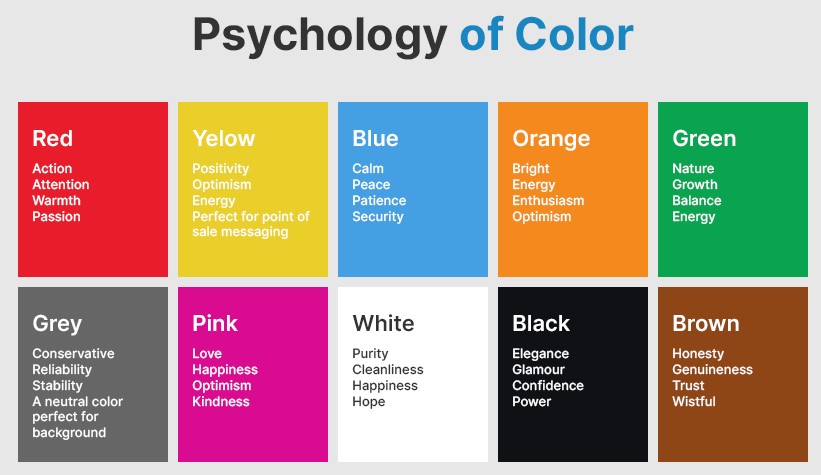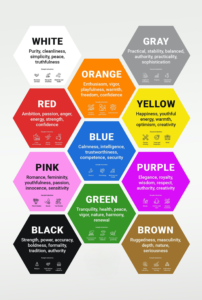Color Psychology: The Silent Power Behind Colors in Branding Perception
In the realm of branding, every element speaks volumes, but perhaps none as silently powerful as color. Colors in branding plays a pivotal role in shaping consumer perceptions, emotions, and ultimately, their decisions. From triggering certain feelings to conveying specific messages, the hues a brand chooses can significantly influence how it is perceived in the market. Let’s delve into the fascinating world of color psychology in branding and uncover how it can help make the right impression.
- Understanding Colors in branding Psychology:
Colors evoke emotions and associations on a subconscious level, making them a potent tool for brand communication. Different colors have different psychological effects. For instance, red can evoke feelings of excitement, passion, and urgency, while blue exudes trust, security, and professionalism. By understanding these nuances, brands can strategically leverage colors to evoke desired emotional responses from their audience.
- Establishing Brand Personality:
Just as individuals have distinct personalities, brands to project their unique identities. Colors in branding plays a crucial role in defining brand personality. For example, vibrant and energetic colors like orange and yellow might be suitable for a youthful and dynamic brand, while muted tones like beige and pastels could convey sophistication and elegance. Selecting the right color palette is integral to ensuring that the brand’s personality aligns with its target audience and market positioning.
- Building Brand Recognition:
Consistency is key in branding, and colors in branding plays a vital role in building brand recognition. Establishing a distinct color scheme helps consumers associate specific colors with a brand, making it instantly recognizable amidst a sea of competitors. Think about the iconic red and white of Coca-Cola or the unmistakable blue of Facebook. These brands have successfully ingrained their chosen colors into the collective consciousness, making them instantly identifiable worldwide.
- Influencing Consumer Perception:
Consumers often make split-second decisions based on their initial perception of a brand. Colors in branding can profoundly impact these perceptions. For instance, a luxury brand might opt for gold or black to convey exclusivity and sophistication, while a health-focused brand might choose green to symbolize freshness and vitality. By strategically selecting colors that resonate with their target audience, brands can shape consumer perceptions in their favor.
- Cultivating Emotional Connections:
Emotions play a significant role in consumer decision-making, and color can be a powerful tool for cultivating emotional connections with a brand. Warm colors like red, orange, and yellow can evoke feelings of warmth, passion, and excitement, while cool colors like blue and green can evoke calmness, trust, and reliability. By tapping into these emotional triggers, brands can forge deeper connections with their audience, fostering loyalty and affinity over time. - Adapting to Cultural Contexts:
It’s essential to recognize that the psychological effects of colors in branding can vary across different cultures and contexts. While white symbolizes purity and innocence in Western cultures, it may signify mourning or death in certain Asian cultures. Similarly, red is associated with luck and prosperity in Chinese culture but may symbolize danger or caution in other contexts. Brands operating in global markets must be mindful of these cultural nuances when selecting colors for their branding initiatives. - Evoking Call-to-Action:
Colors can also influence consumer behavior, particularly when it comes to call-to-action elements such as buttons and links. Studies have shown that certain colors, such as red and orange, are more effective at grabbing attention and encouraging action than others. By strategically incorporating these attention-grabbing colors into their design elements, brands can increase engagement and drive desired actions from their audience.
In conclusion, the psychology of colors in branding is a complex yet powerful tool for shaping consumer perceptions, emotions, and behaviors. By understanding the psychological effects of different colors and strategically incorporating them into their branding initiatives, brands can make a lasting impression, foster emotional connections, and ultimately drive success in the market. As the saying goes, “Color is a power which directly influences the soul.” When wielded effectively, it can indeed be a formidable force in the world of branding.
Color psychology in branding is a powerful tool for shaping perceptions and driving consumer behavior. At Click 400 Technologies, we specialize in comprehensive marketing solutions tailored to your needs. With our expertise, we’re your one-stop solution for all your marketing needs, helping you stand out and succeed in the competitive market. Choose the right colors, make the right impression, and let us handle the rest.



